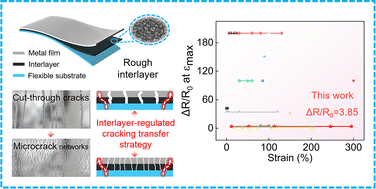Switching ultra-stretchability and sensitivity in metal films for electronic skins: a pufferfish-inspired, interlayer regulation strategy†
Abstract
The booming development of electronic skins necessitates stretchable electrodes and flexible sensors that exhibit distinctly opposite requirements of electromechanical properties, both of which are difficult to be fulfilled on a single material. Here, a pufferfish-inspired, interlayer regulation strategy is proposed that realizes the above opposite properties in simple metal films, exhibiting either ultra-stretchability (295% strain) or sensitivity (maximum GF: ∼5500) on demand. It is revealed that the stretchability of the intrinsically strain-sensitive metal films can be improved by ∼20-fold via regulating the surface morphology of the inserted interlayer, accompanied by an intriguing transition in film cracking behavior from cut-through cracks to network patterns. By featuring these two antithetical but valuable properties, common metal films can be applied as diverse sensors and stretchable electrodes in electronic skins, showing application prospects in healthcare monitoring, human–machine interaction, and engineering services. Our proposed strategy substantially advances the application of metal film conductors in flexible electronics and broadens the horizons for developing more sophisticated electronic skins by interlayer engineering.



 Please wait while we load your content...
Please wait while we load your content...